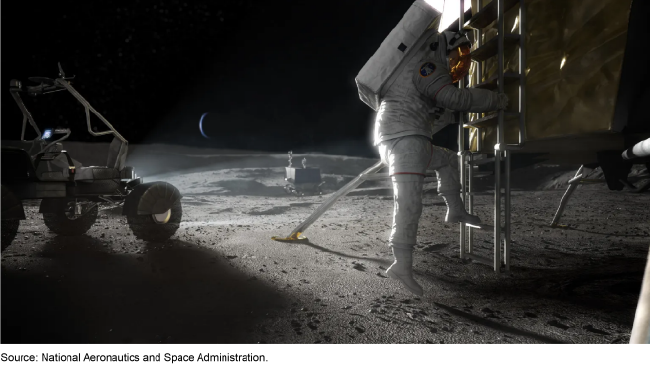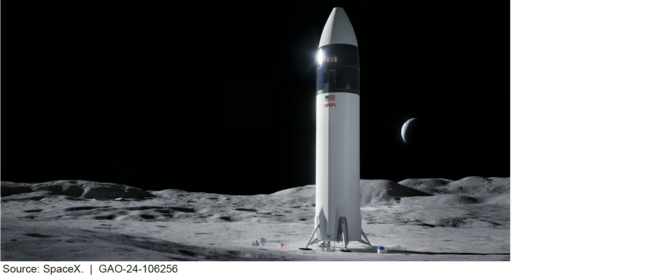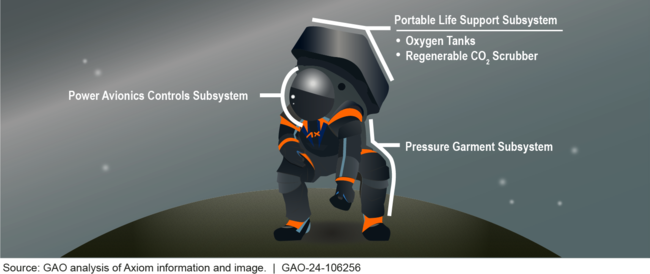NASA Artemis Programs: Crewed Moon Landing Faces Multiple Challenges
Fast Facts
NASA is taking steps to return astronauts to the moon for the first time since 1972—in a mission called Artemis III.
NASA and its contractors made progress since our last report on the Artemis missions, but they are still facing challenges with developing the lunar lander and space suits. For example, some flight tests have been delayed, which could affect the timing of subsequent tests. And a significant amount of complex work remains. As a result, we found that the lunar landing mission is unlikely to occur in 2025 as planned.
In the course of our work, NASA stated it was reviewing the schedule for developing the lunar lander.
Artist’s Rendition of an Astronaut on the Moon

Highlights
What GAO Found
The National Aeronautics and Space Administration (NASA) is preparing to land humans on the moon for the first time since 1972 in a mission known as Artemis III. Since GAO's September 2022 report (GAO-22-105323), NASA and its contractors have made progress, including completing several important milestones, but they still face multiple challenges with development of the human landing system and the space suits. As a result, GAO found that the Artemis III crewed lunar landing is unlikely to occur in 2025. In July 2023, NASA stated that it is reviewing the Human Landing System schedule.
The current challenges that GAO identified include:
- An ambitious schedule: The Human Landing System program is aiming to complete its development—from project start to launch—in 79 months, which is 13 months shorter than the average for NASA major projects. The complexity of human spaceflight suggests that it is unrealistic to expect the program to complete development more than a year faster than the average for NASA major projects, the majority of which are not human spaceflight projects. GAO found that if development took as long as the average for NASA major projects, the Artemis III mission would likely occur in early 2027.
- Delays to key events: As of September 2023, the Human Landing System program had delayed eight of 13 key events by at least 6 months. Two of these events have been delayed to 2025—the year the lander is planned to launch. The delays were caused in part by the Orbital Flight Test, which was intended to demonstrate certain features of the launch vehicle and lander configuration in flight. The test was delayed by 7 months to April 2023. It was then terminated early when the vehicle deviated from its expected trajectory and began to tumble. Subsequent tests rely on successful completion of a second Orbital Flight Test.
Notional Depiction of the Human Landing System
- A large volume of remaining work: SpaceX must complete a significant amount of complex technical work to support the Artemis III lunar landing mission, including developing the ability to store and transfer propellant while in orbit. A critical aspect of SpaceX's plan for landing astronauts on the moon for Artemis III is launching multiple tankers that will transfer propellant to a depot in space before transferring that propellant to the human landing system. NASA documentation states that SpaceX has made limited progress maturing the technologies needed to support this aspect of its plan.
- Design challenges: Axiom is leveraging many aspects of NASA's prior work to develop modernized space suits, but significant work remains to resolve design challenges. For example, NASA's original design did not provide the minimum amount of emergency life support needed for the Artemis III mission. As a result, Axiom representatives said they may redesign certain aspects of the space suit, which could delay its delivery for the mission.
Illustration of Axiom's Space Suit and Major System Components
NASA plans to take multiple steps to determine whether SpaceX's and Axiom's systems meet its mission needs and are safe for crew. For example, NASA developed a supplemental process—one not required by its policies—to determine whether the contractors' systems meet requirements before the mission. Also, NASA's contracting approach to acquire the human landing system and space suits as services included insight clauses in the SpaceX and Axiom contracts. Program officials stated these clauses ensure that NASA has visibility into broad aspects of the contractors' development work, including anything that could affect the Artemis III mission or crew safety. Officials stated that this visibility extends to certain aspects of work SpaceX and Axiom are doing for their commercial endeavors. For example, this included SpaceX's activities leading up to the Orbital Flight Test, which flew a commercial variant of the human landing system.
Why GAO Did This Study
NASA is returning humans to the moon to maintain U.S. leadership in space exploration and prepare for future missions to Mars. NASA is implementing the Artemis missions to meet these goals. To accomplish the Artemis III mission as planned by December 2025, NASA needs to develop, acquire, and integrate several new systems. These include a system to transport crew to and from the lunar surface, and space suits for lunar surface operations. NASA is using a relatively new approach to acquire the human landing system and space suits that is intended to increase innovation and improve affordability. To develop the lunar lander, NASA awarded a contract option to SpaceX in 2021. To develop Artemis space suits, it awarded a contract to Axiom Space in 2022.
A House report includes a provision for GAO to review NASA's lunar programs. This is GAO's fourth report examining the Artemis enterprise.
This report describes the extent to which NASA has made progress in developing key systems needed to land humans on the moon in 2025, and has processes in place to ensure that those systems will meet NASA's needs and be safe.
GAO assessed NASA data, documentation, and policy; analyzed contract documentation, contractor risk charts, and technology maturation plans; and interviewed NASA officials and industry representatives.
For more information, contact William Russell at (202) 512-4841 or russellw@gao.gov.
